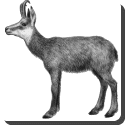 Chamois — The chamois (Rupicapra rupicapra) is a goat-like animal native to the European Alps, the Corno Grande region of the central Italian Apennines, the Tatra Mountains, the Balkans, parts of Turkey, and the Caucasus. The species was also introduced on the South Island of New Zealand. Chamois are strictly protected animals under the European Habitats Directive.
Chamois — The chamois (Rupicapra rupicapra) is a goat-like animal native to the European Alps, the Corno Grande region of the central Italian Apennines, the Tatra Mountains, the Balkans, parts of Turkey, and the Caucasus. The species was also introduced on the South Island of New Zealand. Chamois are strictly protected animals under the European Habitats Directive.
There are two species of chamois in the genus Rupicapra. In addition to the type species, R. rupicapra, there is the Pyrenean chamois, R. pyrenaica. Chamois are in the subfamily Caprinae of the family Bovidae, along with sheep and goats. The French name chamois comes from Latin camox, a borrowing from Gaulish.
The German name for the chamois is Gämse. The male is called a Gämsbock. In English, the term gemsbok has been misapplied to a species of sub-Saharan antelope of the genus Oryx.
Chamois live at moderately high altitudes and are adapted to living in steep, rugged, rocky terrain. A fully grown chamois reaches a height of about 75 cm (2½ feet) and weighs about 50 kg (110 pounds). Males and females have short horns which are slightly curled in the posterior direction. In summer, the fur has a rich brown colour which turns to a light grey in winter. Distinct characteristics are a white face with pronounced black infraorbital stripes, a white rump and a black dorsal stripe. Chamois can reach an age of up to 20 years.
Female chamois and their kids live in herds; adult males tend to live solitarily for most of the year. During the rut (late November/early December in Europe, May in New Zealand), males engage in fierce battles for the attention of unbred females. An impregnated female undergoes a gestation period of 20 weeks, after which a single kid is born. The kid is fully grown by three years of age.
 Kids Portal For Parents India Kids Network
Kids Portal For Parents India Kids Network






